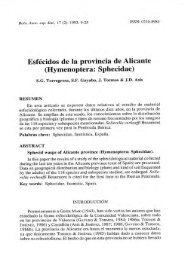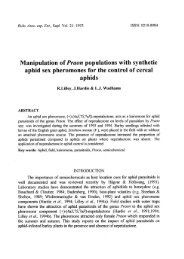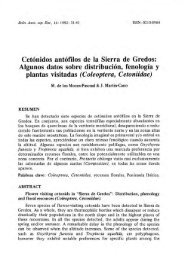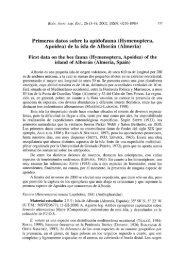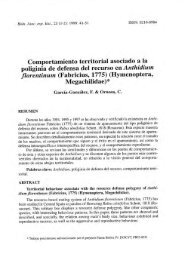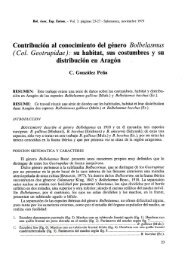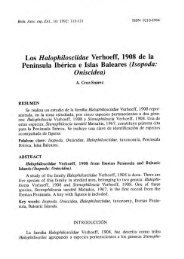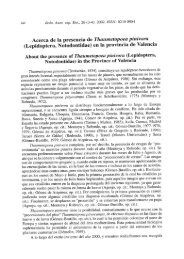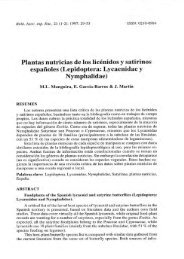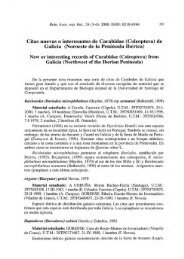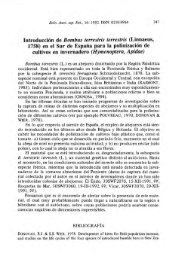Libro 1.indb
Libro 1.indb
Libro 1.indb
You also want an ePaper? Increase the reach of your titles
YUMPU automatically turns print PDFs into web optimized ePapers that Google loves.
GALL MIDGES (DIPTERA: CECIDOMYIIDAE) OF THE IBERIAN PENINSULA 119<br />
(= Q. humilis Lam.) and Q. pyrenaica Willd. (Fagaceae). The gall is formed of folded leaf<br />
lobe downwards. Occurrence: frequent (Fig. 90); Matadepera (1980-1986, new finding),<br />
El Montseny (Barcelona, 1980-1985, new finding), La Panadella (Lleida, 2002, new finding),<br />
Cornudella del Montsant (1997, new finding), Ventalló (Girona, 1999, new finding),<br />
Engolasters, Juberri, La Massana, Santa Coloma, San Julià de Lòria (Andorra, 1992-1995).<br />
References: TAVARES (1907a, 1909, 1916a, 1931), COGOLLUDO (1921), VILARRÚBIA<br />
(1936), SKUHRAVÁ et al. (1996), BELLIDO et al. (2003). Distribution: European.<br />
Macrodiplosis roboris (Hardy, 1854)<br />
Macrodiplosis volvens Kieffer, 1895<br />
Larvae cause galls on Quercus robur L., Q. petraea Liebl. and Q. pubescens Willd. (= Q.<br />
humilis Lam.) (Fagaceae). The gall is formed of rolled up the leaf margin usually between<br />
lobes. Occurrence: medium frequent (Fig. 90); Matadepera (Barcelona, 1980-1986, new<br />
finding), El Montseny (Barcelona,1980-1985, new finding), La Panadella (Lleida, 2002, new<br />
finding), Santa Coloma and Sant Julià de Lòria (Andorra 1992-1995) leg. Pujade-Villar. References:<br />
TAVARES (1905a, 1907a, 1909, 1921, 1931), VILARRÚBIA (1936), SKUHRAVÁ<br />
et al. (1996), BELLIDO et al. (2003). Distribution: European.<br />
Macrolabis aquilegiae (Kieffer, 1909)<br />
Perrisia aquilegiae Kieffer, 1909<br />
Larvae change in galls the flower buds of Aquilegia vulgaris L. (Ranunculaceae). Nijveldt<br />
(1977) redescribed this species and placed it in the genus Macrolabis Kieffer. Occurrence:<br />
very scarce (Fig. 91). Reference: TROTTER (1902a). Distribution: European.<br />
Macrolabis brunellae Tavares, 1907<br />
Macrolabis brunellae Rübsaamen, 1921, new synonym<br />
Macrolabis ruebsaameni Hedicke, 1938, new synonym<br />
Larvae change into galls the leaf and flower buds of Prunella vulgaris L. (Lamiaceae). Occurrence:<br />
scarce (Fig. 91). References: TAVARES (1907a, 1909, 1919, 1920), COGOLLUDO<br />
(1921). Distribution: Mediterranean. - This species is identical with Macrolabis ruebsaameni<br />
Hedicke, 1938 (as a new name for M. brunellae Rübsaamen, 1921) and they are new synonyms<br />
of M. brunellae Tavares, 1907.<br />
Macrolabis heraclei (Kaltenbach, 1862)<br />
Cecidomyia corrugans F. Löw, 1877<br />
Macrolabis tamujana Tavares, 1922<br />
Larvae cause leaf galls on Heracleum sphondylium L. (Apiaceae). The gall is formed of a<br />
folded and curled leaf. Occurrence: scarce (Fig. 92). Reference: TAVARES (1922). Distribution:<br />
Euro-Siberian.<br />
Macrolabis hippocrepidis Kieffer, 1898<br />
Larvae develop in folded leaflets of Hippocrepis valentina Bss. (Fabaceae). Occurrence: very<br />
scarce (Fig. 92). Reference: TAVARES (1931). Distribution: European.<br />
Macrolabis marteli Kieffer, 1892<br />
Larvae develop in downwards rolled leaf margins of Hypericum perforatum L. (Hypericaceae).<br />
Occurrence: very scarce (Fig. 93); Montseny (Barcelona, 1994) leg. Pujade-Villar. Reference:<br />
SKUHRAVÁ et al. (1996). Distribution: European.<br />
Boln. Asoc. esp. Ent., 30 (1-2): 93-159, 2006



